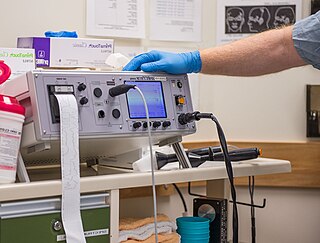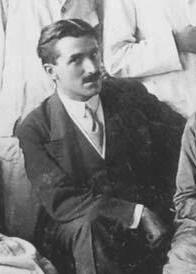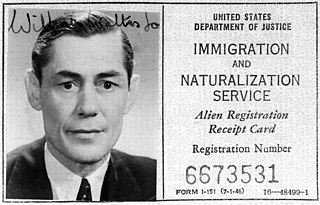Related Research Articles

Electroconvulsive therapy (ECT) is a psychiatric treatment where a generalized seizure is electrically induced to manage refractory mental disorders. Typically, 70 to 120 volts are applied externally to the patient's head, resulting in approximately 800 milliamperes of direct current passing between the electrodes, for a duration of 100 milliseconds to 6 seconds, either from temple to temple or from front to back of one side of the head. However, only about 1% of the electrical current crosses the bony skull into the brain because skull impedance is about 100 times higher than skin impedance.

Ugo Cerletti was an Italian neurologist who discovered the method of electroconvulsive therapy (ECT) used in psychiatry. Electroconvulsive therapy is a therapy in which electric current is used to provoke a seizure for a short duration. This therapy is used in an attempt to treat certain mental disorders, and may be useful when other possible treatments have not, or cannot, cure the person of their mental disorder.
Ladislas Joseph Meduna, a Hungarian neuropathologist and neuropsychiatrist, initiated convulsive treatment, the repeated induction of grand mal seizures in the treatment for psychosis. Observing the high concentration of glia in post-mortem brains of patients with epilepsy and a paucity in those with schizophrenia, he proposed that schizophrenia might be treated by inducing "epileptic" seizures. Thus, chemically induced seizures became the electroconvulsive therapy that is now in worldwide use.
Peter Roger Breggin is an American psychiatrist and critic of shock treatment and psychiatric medication and Covid-19 response. In his books, he advocates replacing psychiatry's use of drugs and electroconvulsive therapy with psychotherapy, education, empathy, love, and broader human services.
MindFreedom International is an international coalition of over one hundred grassroots groups and thousands of individual members from fourteen nations. Based in the United States, it was founded in 1990 to advocate against forced medication, medical restraints, and involuntary electroconvulsive therapy. Its stated mission is to protect the rights of people who have been labeled with psychiatric disorders. Membership is open to anyone who supports human rights, including mental health professionals, advocates, activists, and family members. MindFreedom has been recognized by the United Nations Economic and Social Council as a human rights NGO with Consultative Roster Status.

William Walters Sargant was a British psychiatrist who is remembered for the evangelical zeal with which he promoted treatments such as psychosurgery, deep sleep treatment, electroconvulsive therapy and insulin shock therapy.

Insulin shock therapy or insulin coma therapy was a form of psychiatric treatment in which patients were repeatedly injected with large doses of insulin in order to produce daily comas over several weeks. It was introduced in 1927 by Austrian-American psychiatrist Manfred Sakel and used extensively in the 1940s and 1950s, mainly for schizophrenia, before falling out of favour and being replaced by neuroleptic drugs in the 1960s.
Deep sleep therapy (DST), also called prolonged sleep treatment or continuous narcosis, is a discredited form of ostensibly psychiatric treatment in which drugs are used to keep patients unconscious for a period of days or weeks. The controversial practice led to the death of 25 patients in Chelmsford Private Hospital in New South Wales, Australia, from the early 1960s to late 1970s.

Lauretta Bender was an American child neuropsychiatrist known for developing the Bender-Gestalt Test, a psychological test designed to evaluate visual-motor maturation in children. First published by Bender in 1938, the test became widely used for assessing children's neurological function and screening for developmental disorders.
Child and adolescent psychiatry is a branch of psychiatry that focuses on the diagnosis, treatment, and prevention of mental disorders in children, adolescents, and their families. It investigates the biopsychosocial factors that influence the development and course of psychiatric disorders and treatment responses to various interventions. Child and adolescent psychiatrists primarily use psychotherapy and/or medication to treat mental disorders in the pediatric population.
Electroconvulsive therapy is a controversial psychiatric treatment in which seizures are induced with electricity. ECT was first used in the United Kingdom in 1939 and, although its use has been declining for several decades, it was still given to about 11,000 people a year in the early 2000s.
Maximilian Fink is an American neurologist and psychiatrist best known for his work on ECT. His early work also included studies on the effect of psychoactive drugs on brain electrical activity; more recently he has written about the syndromes of catatonia and melancholia.
Linda Andre is an American psychiatric survivor activist and writer, living in New York City, who is the director of the Committee for Truth in Psychiatry (CTIP), an organization founded by Marilyn Rice in 1984 to encourage the U.S. Food and Drug Administration (FDA) to regulate electroconvulsive therapy (ECT) machines.
Leonard Roy Frank was an American human rights activist, psychiatric survivor, editor, writer, aphorist, and lecturer.

Sarah H. Lisanby is an American psychiatrist who studies the use of neurostimulation devices to treat mental illness. Since 2015 she has directed the division of the National Institute of Mental Health(NIMH) working on translational research.
Yang Yongxin is a highly controversial Chinese clinical psychiatrist who advocated and practiced electroconvulsive therapy (ECT) without anaesthesia or muscle relaxants as a cure for alleged video game and Internet addiction in adolescents. Yang is currently deputy chief of the Fourth Hospital of Linyi, in the Shandong province of China. He runs the Internet Addiction Treatment Center at the hospital.

David John Impastato, M.D. – born January 8, 1903, died February 28, 1986 – was a neuropsychiatrist who pioneered the use of electroconvulsive therapy (ECT) in the United States. A treatment for mental illness initially called "electroshock," ECT was developed in 1937 by Dr. Ugo Cerletti and Lucio Bini, working in Rome. Impastato has been credited with the earliest documented use of the revolutionary method in North America, administered in early 1940 to a schizophrenic female patient in New York City. Soon after, he and colleague Dr. Renato Almansi completed the first case study of ECT to appear in a U.S. publication. Impastato spent the next four decades refining the technique, gaining recognition as one of its most authoritative spokesmen. He taught, lectured widely and published over fifty articles on his work. He called on ECT practitioners to observe the strictest protocols of patient safety, countered resistance to ECT from both the medical and cultural establishments, and met later challenges to electroconvulsive therapy from developments in psychopharmacology. Impastato would live to see ECT recommended by the American Psychiatric Association for a distinct core of intractable mental disorders. The U.S. Food and Drug Administration took longer to respond to the treatment's potential. But in 2016 the FDA drafted guidelines for ECT similar to those of the APA, as well as proposing regulations for treatment with Class II and Class III devices. Though still not free of controversy, electroconvulsive therapy is the treatment of choice for an estimated 100,000 patients a year in the United States.
Psychiatry is, and has historically been, viewed as controversial by those under its care, as well as sociologists and psychiatrists themselves. There are a variety of reasons cited for this controversy, including the subjectivity of diagnosis, the use of diagnosis and treatment for social and political control including detaining citizens and treating them without consent, the side effects of treatments such as electroconvulsive therapy, antipsychotics and historical procedures like the lobotomy and other forms of psychosurgery or insulin shock therapy, and the history of racism within the profession in the United States.
The Montreal experiments were a series of experiments, initially aimed to treat schizophrenia by changing memories and erasing the patients' thoughts using Donald Ewen Cameron's method of “psychic driving”, as well as drug-induced sleep, intensive electroconvulsive therapy, sensory deprivation and Thorazine. The experiments were conducted at the Allan Memorial Institute of McGill University between 1957 and 1964 by the Scottish psychiatrist Donald Ewen Cameron and funded by the CIA as part of Project MKUltra, which lasted until 1973 and was only revealed to the public in 1975.
References
- ↑ Chabasinski and Chamberlin separated in 1974, two years after their marriage, and remained close friends. They divorced in 1985 when Chabasinski wanted to remarry.
- ↑ Ellen Goodman. The Free Lance-Star - Nov 20, 1982
- ↑ City's electroshock vote affecting treatment. The New York Times. 5 November 1982
- 1 2 3 Anon. "Personal stories (interview)". MindFreedom International. Retrieved 25 March 2011.
- 1 2 3 4 5 6 7 Boodman, Sandra G. (24 September 1996). "Shock therapy: it's back". Washington Post.
- 1 2 Isaac, Rael Jean and Armat, Virginia C. (1992). Madness in the streets : how psychiatry and the law abandoned the mentally ill (1st Free Press pbk. ed.). New York: Free Press. p. 167. ISBN 0-02-915381-6.
- ↑ Chess, Stella (1995). "Lauretta Bender, M.D., 1899-1987". The American Journal of Psychiatry. 192 (3): 436. doi:10.1176/ajp.152.3.436.
- 1 2 3 Shorter, Edward, and Healy, David (2007). Shock therapy : a history of electroconvulsive treatment in mental illness (1. publ. ed.). New Brunswick, N.J.: Rutgers University Press. p. 137. ISBN 978-0-8135-4169-3.
- 1 2 Stone, Gene (14 November 1994). "Short, Sharp, Shock". New York Magazine: 56. Retrieved 24 March 2011.
- 1 2 Young, Mary de (2010). Madness : an American history of mental illness and its treatment. Jefferson, N.C.: McFarland & Co. p. 218. ISBN 978-0-7864-3398-8.
- 1 2 3 4 5 6 Hill, Gladwin (31 October 1982). "Now therapy by the ballot". The New York Times. Retrieved 23 March 2011.
- 1 2 3 4 5 6 7 Rice, John (24 August 1982). "Berkeley to vote on banning electroshock therapy". Associated Press.
- 1 2 3 Clark, Matt (25 October 1982). "Voting on electroshock". Newsweek.
- ↑ Rey, Joseph M., and Walter, Gary (May 1997). "Half a century of ECT use in young people". The American Journal of Psychiatry. 154 (5): 596. doi: 10.1176/ajp.154.5.595 . PMID 9137112.
- 1 2 3 4 Sullivan, Valerie (30 October 1982). "General news: Berkeley, California". United Press International.
- 1 2 3 4 Altman, Laurence K. (5 November 1982). "City's electroshock vote affecting treatment". The New York Times. Retrieved 23 March 2011.
- ↑ Supeene, Shelagh Lynne (1990). As For The Sky, Falling : a Critical Look at Psychiatry and Suffering. Toronto, Canada: Second Story Press. p. 234. ISBN 0-929005-09-0.
- ↑ Anon. (9 November 1982). "Psychotherapy by ballot". The New York Times. Retrieved 23 March 2011.
- ↑ Sherlock, Richard K.; Haykal, Radwan F.; Dresser, Rebecca (Dec 1982). "Case studies: saying 'no' to electroshock". The Hastings Center Report. 12 (6): 19. doi:10.2307/3561358. JSTOR 3561358.
- 1 2 3 Anon. (3 November 1982). "Berkeley bans electroshock". The Associated Press.
- ↑ Anon. (14 January 1983). "Electroshock ban sponsors react to injunction". The Associated Press.
- ↑ Anon. "Interview with Ted Chabasinski". MindFreedom International. Retrieved 23 March 2011.
- ↑ Pringle, Evelyn (8 January 2007). "Lilly's legal battle over Zyprexa documents continues". LawyersandSettlements.com. Retrieved 25 March 2011.